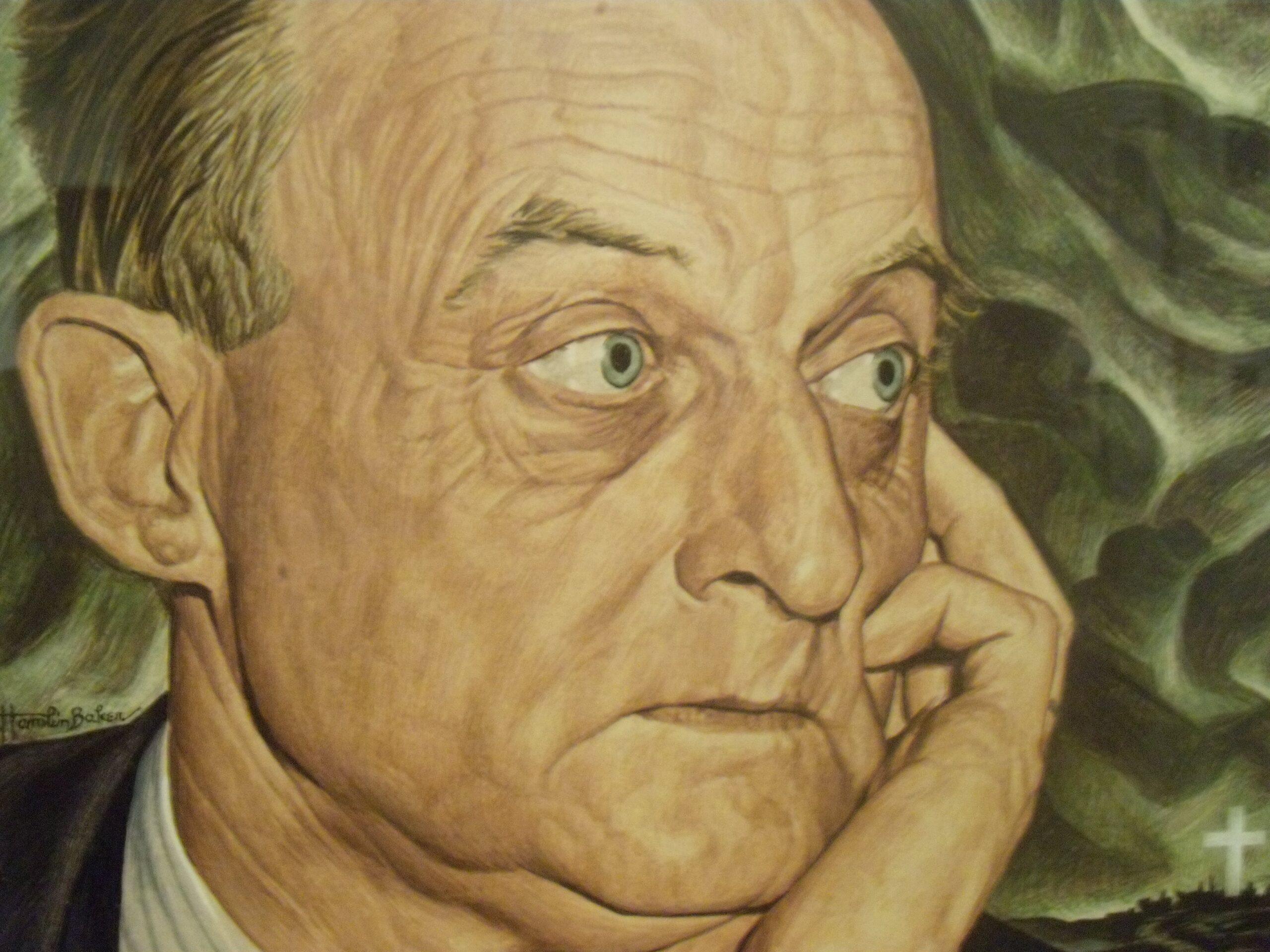One of William Faulkner’s most famous lines (from Requiem for a Nun) is “The past is never dead. It’s not even past.” In our era, this has become true of our relationship to art in a way that Faulkner could never have anticipated. As the harvest of every climate is available on our supermarket shelves, so the creative harvest of every era is available at the touch of our fingertips, and like a disc jockey we skip from a song from the ’50s to a film from the ’90s to a video that dropped the day before yesterday, governed only by our own sense of taste and the hidden guiding hand of the algorithm.
The past, in a meaningful sense, really isn’t past anymore because we approach it in the same way as we do everything else in our present, as an interchangeable element in the bricolage of now.
Our contemporary iconoclasm may be in part a consequence of this development. If thy right hand offend thee, the Gospel of Matthew advises, cut it off, so if some relic of the past offends, tempting us to sin, why shouldn’t we expunge it? When it is hard to argue that a given work of art or memorial tribute is inoffensive (as it often legitimately is), the defense against iconoclasm requires arguing that the offensive hand is not truly thine, or thine alone, because the relics of the past are not merely an assemblage curated for our delectation, but a living body of which we are a member.
Meanwhile, the flip side of this coin is our affinity for playing dress-up. We reimagine the Founding Fathers as downtown hip-hop artists rhyming revolution, or Emily Dickinson as a contemporary teen, and when we do it well we make startling and moving connections thereby. Yet if the past were actually a foreign country, I have no doubt that our typical contemporary approach to it would be denounced as appropriative and colonialist.
Mindful of the foregoing, I’m always on the lookout for works of art that actively engage our relationship with the past in a self-aware and novel way. Edgar Wright’s latest film, Last Night in Soho, seemed like a promising possibility in that regard, inasmuch as it appeared to be explicitly about the allure and danger of second-hand nostalgia. In an effort to protect his protagonist from confronting herself, however, he winds up demonstrating how much our affinity for cosplay depends on our iconoclasm.
When we first meet Wright’s protagonist, Eloise (Thomasin McKenzie) is an exuberant small-town girl with big city dreams. Her mother (Aimee Cassettari) having died by suicide when she was a small child and her father never having entered the picture, Eloise was raised by her grandmother (Rita Tushingham) in Cornwall and has marinated herself in the culture of her grandmother’s youth: the London of the swinging sixties. Eloise’s walls are plastered with film and music posters from the era, her record player spins her grandmother’s vintage vinyl, and for herself to wear she has fashioned a dress out of old magazines in which she might imagine being mistaken for Audrey Hepburn. Eloise is a budding seamstress, and her particular dream—which she learns within minutes of the film’s opening will soon be realized—is to go to London, become a fashion designer, and through her art reweave her beloved bygone era back to life.
The only cloud on the horizon is that her dead mother will tend to appear in mirrors from time to time, haunting her daughter with the knowledge that it was moving to London that did her in. That’s a setup that prompts the viewer to expect a reckoning with the past of one sort or another. Perhaps Eloise will learn what happened to her mother—perhaps, indeed, it will begin to happen to her as well, and either end her life or force her to make some change to escape death. Her mother’s ghost could prove to be the nemesis, or, alternatively, the salvation of the daughter she never got to see grow up. The glossy sixties could be a dangerous fantasy that draws Eloise in, and away from the real life she ought to be inhabiting in the here and now, or it could be a haven from which Eloise learns what she needs to master her present troubles as well as the legacy of her own past.
Wright flirts with all of these possibilities, but for much of the movie he can’t seem to decide what exactly he’s going to do with all of them.
We start with the sanctuary theme. While Eloise is exuberant at home, she is shy, anxious and withdrawn in company, and far from trying to stand out sartorially she dresses in mousy, even spinsterish fashion. Eloise’s roommate at school, Jocasta (Synnøve Karlsen), is a mean girl who immediately begins to tease and undermine her. So after one miserable night out with her new “friends,” Eloise flees the school dormitories for a bedsit that seems tailor-made for her, as it has been untouched since the era of her obsession, when the elderly landlady, Ms. Collins (Diana Rigg) was herself a young woman.
Lit by a blinking neon sign for the bistro downstairs, the room feels like a set, and Eloise quickly casts herself in a scenario right out of a vintage melodrama. Every night when she goes to sleep she enters the world of her dreams, Soho in the mid-1960s, and shadows a beautiful, flirtatious, and determined young woman, Sandie (Anya Taylor-Joy), who is out to break into show business as a singer and who used to live in the very room where Eloise now resides. And how does Eloise shadow her? By appearing as the reflection in mirrors (which abounded on surfaces everywhere at the time), much as her mother haunts her in her waking hours.
Initially, these nocturnal journeys fuel her daytime creativity. She spruces up her own hair and wardrobe with touches drawn from her dreams, and she begins designing clothes modeled on the baby-doll dress her avatar wears. Sandie, too, seems to be living her dream life, meeting a man at a bar, Jack (Matt Smith), who presents as a producer or agent of some sort, and who promises to get her onstage and then arranges an audition at a less-prestigious but still substantial music hall.
But the dream quickly turns into a nightmare. The music hall turns out to be a burlesque joint, where Sandie will dance in her scanties but never sing. Jack introduces her to male “friends” of his and pressures her to sleep with them to advance her career; before long, he has turned her into a common prostitute and himself into her domineering and violent pimp. Eloise can only look on in horror, screaming helplessly from the other side of the mirror.
Then the nightmares break through into her waking life. Eloise has a vision of Sandie being stabbed to death in her own bed by Jack and becomes convinced that the murderer is still alive, and following her. Meanwhile, zombified shape-shifting forms of Sandie’s old clients stalk her through the London streets and the hallways of her school.
For the bulk of the film, the most parsimonious explanation for these fantastical effusions is that they are a manifestation of Eloise’s own psychic disturbance. The film gives us ample clues, moreover, as to the nature of this disturbance: a terror of the opposite sex. The first person she meets in London is a cabbie who is shockingly lewd, practically slavering over her. On her first night out with her roommate—named Jocasta, for heaven’s sake—she spots a silver-haired gentleman (Terence Stamp) coming out of a massage parlor; when they make eye contact, he smirks, and she flinches, and every time she sees him thereafter in the film a chill runs down her spine, though in truth he’s done nothing alarming.
At the bar, men flirt with her in a gross fashion, so she leaves, and later the same night she is driven from her room when Jocasta brings home a man and begins to undress in the next bed over. Contemporary relations between the sexes are portrayed as gruesome and tawdry, but Eloise is the only one sensitive enough to be bothered by that fact, so she flees to her bedsit as a sanctuary.
Yet, as Philip Larkin memorably wrote, sexual intercourse began in nineteen sixty-three. Mid-’60s London, the era that Eloise idealizes, was all about sexuality bursting forth as the courtship rules of an earlier age that had been loosening for decades finally and completely broke down. Eloise cannot possibly not know this. It has to be what she is drawn to, but also what terrifies her. Her dream is a dream of safe sex, of living the life of a liberated and confident girl of the era while safely hidden behind glass, something that should resonate with young people today increasingly inclined to do precisely the same thing via their phones. But her terror will not let that dream be, and must turn it into a lurid tale of abuse, degradation and murder.
If these terrors were effusions of her psyche, whether real or imagined, then what we would have is a story about a fragile personality in a brutal world, like Brian DePalma’s Carrie, and we would be moved to pity and terror by a recognition of our commonality with both that fragility and that brutality. But Wright, notwithstanding the Italian giallo horror films that inspired so much of the look of his film, flinches from locating the source of horror in his protagonist, or in the interplay between her and the brutal world. He’s as invested in her purity, her plucky independence, and her quest for safety as she is, and this determination to keep her safe is precisely what drives his film off the rails.
Eloise’s vision of Sandie’s murder hews perfectly to the pattern of sexual terror established to that point. She’s in bed, making out with a preternaturally sweet boy, John (Michael Ajao), when she sees the stabbing in a mirror on the ceiling. (There is no mirror on her ceiling; that’s another breakthrough from her sixties vision.) Eloise screams and shoves John aside, drawing the attention of her landlady, who threatens to call the police. John, realizing just what a precarious position he’s in as a young black man in a hysterical, hallucinating white girl’s room, bolts. It seems, for a moment, that her terror of sexuality might have real consequences, ruining a budding relationship with someone who is the opposite of everything she fears.
But John does not avoid her thereafter, nor after she attempts to stab Jocasta in the face with a pair of shears (Eloise wrongly mistakes her for one of Sandie’s zombie johns), nor after she causes the old man from the massage parlor to be struck by a car and possibly killed (Eloise wrongly believes him to be Jack, still alive and unpunished), nor even when he himself is stabbed in the belly. That last event happens shortly after we find out that everything Eloise has experienced is real, and that none of it is actually related to her.
It turns out that Ms. Collins, the landlady, who now calls herself Alex, once went by Sandie. Everything Eloise saw in her visions actually did happen to her, and in that room—with one twist. All those threatening zombie figures are the ghosts of the men she was forced to sleep with, who in real life she murdered, as she also murdered Jack, and what they want from Eloise now is to destroy their murderess. Ms. Collins drugs Eloise, pursuant to killing her, and stabs her boyfriend, but is undone when she accidentally sets her own house on fire: a cigarette falls into a box of vinyl records, the same music that Eloise is always listening to.
Eloise takes the time to pronounce her forgiveness, since Alex was herself a victim, and to be blessed in turn, and is then rescued along with John by entering firefighters. The last scene of the film takes place some weeks later, when everyone has recovered, and she is triumphantly watching her first collection of ’60s-inspired duds on the runway as John, her grandmother, and the mirror-dwelling ghost of her mother look on with pride.
What are we supposed to make of this ending? Literally, it suggests that to make all these beautiful relics of the past safe for contemporary people to listen to and wear, their original context must go up in smoke. That’s an unfortunate place for a vintage collector like Wright to end up. Wright himself manifests such an uncomplicated and unabashed love for film and music history. He has peppered his film with references to movies of the era, tenderly recreated styles and locations, and cast icons of the era (Diana Rigg famously broke out as a star of The Avengers, and Rita Tushingham was the lead in such British ’60s films as A Taste of Honey, The Knack… and How to Get It, and The Bed Sitting Room) in roles that played off their histories. I’d be satisfied if he continued to be a collector, but I am saddened if an attempt to deepen that relationship with the past, to really delve into a world he loved, caused him to freeze, fearing that he might wind up appreciating something of which contemporary audiences wouldn’t approve.
I’m more disappointed, though, with what it means for Eloise. London may be a lot, as the repeated line of the film has it, but Eloise brought plenty with her. Wright has done her no favors by suggesting that the answer to her terror lies in burning down the house where, for all that it seems like it was made for her, she’s really only a temporary tenant.
Noah Millman is theater and film critic for Modern Age and a columnist for The Week.














